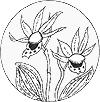PHOTO GALLERY
Got photos?
Photo Gallery is not currently being updated. Current photos are accesible via individual Wildflower Tours on the Wildflower Tours under listings for each location.
Page: 1 2
(Photos shown with latest received at the top.)
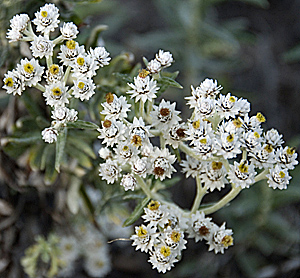 December 2, 2011: Greenwood State Beach, Elk
December 2, 2011: Greenwood State Beach, ElkHere are a few photos I got around the time of the 2011 DKY Potluck. There were a surprising number of plants in bloom or fruiting, and warm, mild weather made for enjoyable explorations. This first one is Pearly everlasting, Anaphalis margaritacea. --Norm Jensen
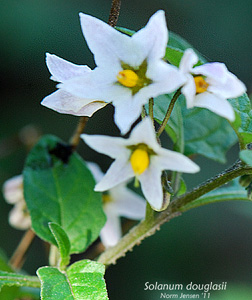 December 3, 2011: Jughandle State Reserve
Douglas' or Greenspot nightshade, Solanum douglasii
December 3, 2011: Jughandle State Reserve
Douglas' or Greenspot nightshade, Solanum douglasii
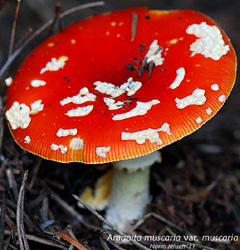 December 3, 2011: Jughandle State Reserve
December 3, 2011: Jughandle State ReserveThe common (in our area) Fly agaric, Amanita muscaria. You don't want to eat it raw, but see this entry on Mykoweb, which says it has been consumed, after proper cooking, by some people.
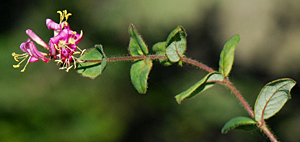 December 5, 2011: North of Irish Beach
December 5, 2011: North of Irish BeachThis is Pink honeysuckle, Lonicera hispidula.
 December 5, 2011: Hearn Gulch
December 5, 2011: Hearn GulchHearn Gulch had a lot going on today, including this Bearberry manzanita or Kinnikinnick (Arctostaphylos uva-ursi). Other plants in bloom were Wight's paintbrush, California goldenrod, and Sticky monkeyflower.
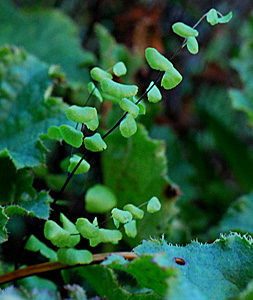 December 5, 2011: Hearn Gulch
December 5, 2011: Hearn GulchNear the bottom of the trail to the little beach, on the bank above eye level to the left, was this California maidenhair fern (Adiantum jordanii). I saw just the one instance of it, though I looked around for more. It was also not on the Hearn Gulch plant list, but has been added now.
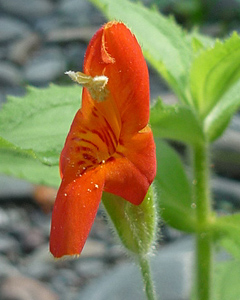 September 29, 2011: South fork Gualala River
September 29, 2011: South fork Gualala RiverScarlet monkeyflower (Mimulus cardinalis). Photograph by Bob Rutemoller. Found in damp or wet places, along streams and in seeps, this is another of our gorgeous native wildflowers. Widespread, from Oregon to Baja, east to Utah, sealevel up to 7000', a mass of these in bloom is breathtaking. Fairly easy to grow in a home garden; they were available at the recent chapter plant sale.
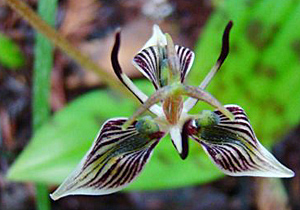 February 5, 2010: Sea Ranch
February 5, 2010: Sea RanchMary Hunter sent this photo of Fetid Adders Tongue or Slink Pod (Scoliopus bigelovii), from Salal Creek on The Sea Ranch. The common name Fetid Adders Tongue comes from a faint bad (to humans) odor of the flowers, which attracts the fungus gnats that polinate it. Slink Pod refers to the heavy seed pod that bends to the ground on a slender stem, making seeds accessible to ants which aid in distribution.
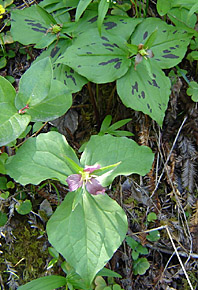 April 28: Annapolis Road
April 28: Annapolis RoadAnn Littlewood from Portland, OR, writes: Toward the end of April, I was fortunate enough to visit Annapolis Road south of Gualala. My sister and I had a wonderful stroll and saw Calypso bulbosa orchids, Scoliopus biglelovii, redwood oxalis, and the magnificent redwoods themselves. Our focus was Trillium ovatum maculosum and we saw many of them. We also visited Fish Road looking for T. o. maculosum and found none.
The photo was taken 4/28/08 and shows the usual form of T. ovatum next to the spotted form, T. o. maculosum.
My understanding is that the spotted form is rare, found most abundantly on Annapolis road. My question is whether the population on this road has any protection or whether public ownership is underway. I believe, based on local signs, that this is a tree farm and therefore subject to harvest and destruction of the understory. Can you tell me the situation?
(Anyone with information about this please forward it to the webmaster and I will send it on to Ann.)
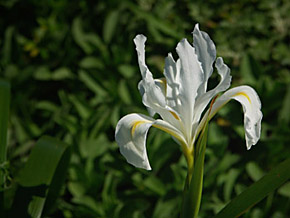 April 6: Alder Creek
April 6: Alder CreekFrom Bob Keller in Mendocino: "Yesterday (April 5) I drove down the coast to Alder Creek Beach and bluffs. It was a perfect balmy day and surprisingly I had the place all to myself. Although the displays were not solid carpets they were still very nice. Expanses of Douglas Iris, cream cups, vivid poppies, paint brush, baby blue eyes, lupines and many others. The unique small group of white Iris there on the blufftop only had one bloom and a couple of buds, but I'm sure more are on the way."
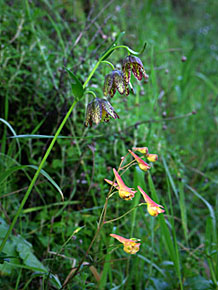 April 6: Alder Creek
April 6: Alder CreekAlso from Bob Keller: "Along Highway 1 south of Elk I stopped at one of my favorite spots. This shot shows a very nice juxtaposition of mission bells (Fritillaria lanceolata) with canyon Delphinium (Delphinium nudicaule), which I was fortunate to spot. Also along this north-facing bank were crimson columbine, star false Solomon's seal, Saxifrage sp., fringe cups and others."
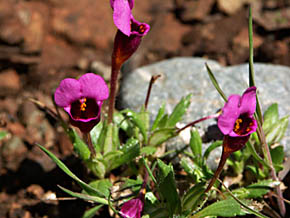 April 3: Walker Ridge
April 3: Walker RidgeBob Keller sent this picture, and asked, "I wonder if anyone can help with an identification of this scrappy little plant, halfway up Walker Ridge, west side of Bear Valley, Colusa County (Inner Coast Range). The flowers are about 5/8" across the front; they rise perhaps 4" above the ground. The leaves are somewhat thick and toothed, as can be seen in the photo."
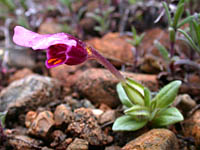 April 4: Oregon
April 4: OregonReply from Norm Jensen: Yep, that's Mimulus douglasii, or purple mouse ears. Isn't it gorgeous? Here is one I got a shot of today, not far from my house. The poor thing had got snowed and rained on all yesterday, but is still hanging in. Scrappy is indeed the word for them!
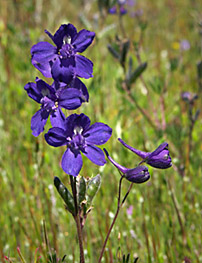 March 30: Bear Valley
March 30: Bear ValleyBob Keller reports: "Made a foray March 30th over to Bear Valley in the inner Coast Range of Colusa County. The recent rains were great for the usually-dusty roads! There were impressive displays everywhere, mostly consisting of Gilia, cream cups, tidytips, goldfields, meadowfoam and others too numerous to list. Lots of lupine; some scattered nice Delphinium, too. The shooting stars are at the end of their bloom. Occasional owl's clover was looking good. Part way up into the serpentine of Walker Ridge were Iris and paint brush. Along the road at the north end I stopped to check out hillsides of wild hyacinth, blue dicks and others. But no adobe lily! I think I was too late."
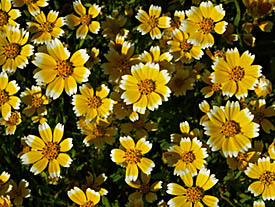 March 30: Bear Valley
March 30: Bear ValleyTidy Tips photo by Bob Keller. (See previous description.)
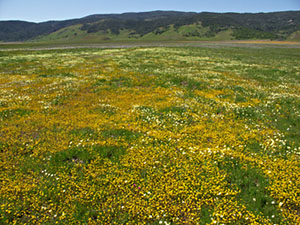 March 30: Bear Valley
March 30: Bear ValleyView of Bear Valley, photo by Bob Keller. (See previous description.)
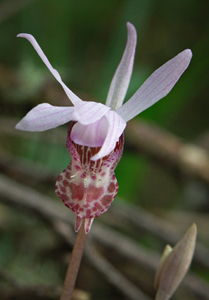 March 15: Cameron Road
March 15: Cameron RoadBob Keller reports, "Yesterday afternoon (3/15) I paid my annual visit to my favorite Calypso patch in a dark Douglas-Fir woods off of Cameron Road. One typically sees at least 40-50 blooms coming up through the heavy forest litter/duff, and scattered among them perhaps 4-6 specimens of a very pale variety. These tend to be not as robust as the normally-colored flowers, and nod downwards giving the impression of not having fully matured or developed. They're more difficult to photograph because of the awkward angle. At any rate, here's a shot of one of them. The following image is the typical bloom in this area, altho' there is considerable variation in the expressions of the top petals."
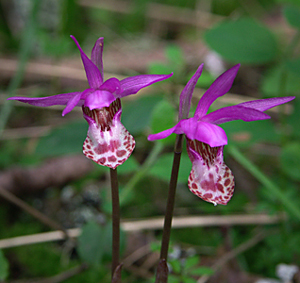 March 15: Cameron Road
March 15: Cameron Road(See previous description.)
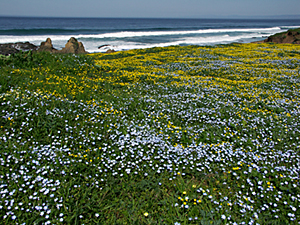 March 15: Glass Beach Bluffs
March 15: Glass Beach BluffsNice scenic and detail photos from Bob Keller. "Yesterday morning (3/15) I ran up to the Glass Beach Bluffs to see what was happening. Wow! A beautiful display of carpets of wildflowers! And a perfect spring day to boot. So here's a general bluff shot and a second shot, which shows the three current principal components of the show together, Baby Blue Eyes, Cream Cups and our local subspecies of the Blennosperma. Aslo in evidence were the local paintbrush and a species of yellow-flowered wallflower. The poppies aren't happening yet, but they will! Their distinctive foliage was everywhere."
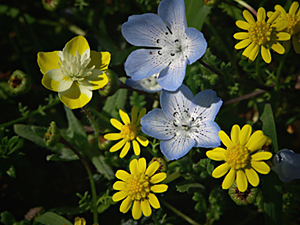 March 15: Glass Beach Bluffs
March 15: Glass Beach Bluffs(See previous description.)
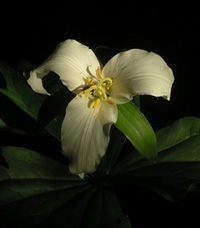 March 11: Jackson State Forest
March 11: Jackson State ForestPhoto by Toni Rizzo, who says the specimen was "near Jughandle Creek about 4 miles inland. Late in the day, the sun formed a perfect spotlight on this lovely Trillium ovatum hiding deep in the forest." This trillium has several common names, including western trillium, wake-robin, pacific trillium, and western wakerobin.
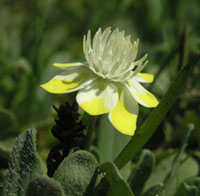 March 10: Ocean bluffs north of Glass Beach
March 10: Ocean bluffs north of Glass BeachThis also from Toni Rizzo. "Platystemon californicus. This pretty cream cup is reaching for the sun on a balmy Spring day." Hardy, adapted to a range of habitats, including oak woodlands, chaparrel, and grasslands, cream cups can be found in nearly all California counties.
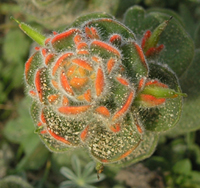 March 9: Ocean bluffs north of Glass Beach
March 9: Ocean bluffs north of Glass Beach"Castilleja mendocinensis. I believe this paintbrush is found only in Mendocino County. The colors and texture are different than any other paintbrush species I've seen." CNPS calls Mendocino coast Indian painbrush very rare. Like all paintbrushes, it is a hemiparasite, meaning it gets some nourishment from a host, and some from photosynthesis. Photo by Toni Rizzo.
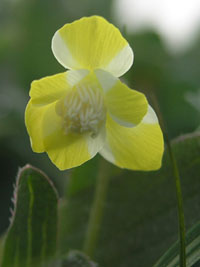 March 9: Ocean bluffs north of Glass Beach
March 9: Ocean bluffs north of Glass BeachPhoto by Toni Rizzo, who says, "Platystemon californicus. Also called cream cups, the delightful lemon and cream contrasts nicely with the surrounding green foliage."
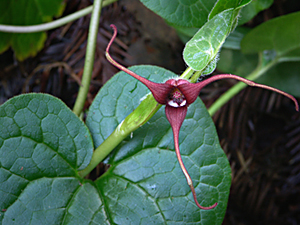 March 8: Big River
March 8: Big RiverThis shot of Long-tailed ginger, Asarum caudatum, was taken "two miles upstream from the Woodlands Camp. This patch of wild ginger was about 30 yards long in shady redwood/mixed forest - the flowers hide beneath the large, aromatic, heart-shaped leaves." Photo by Bob Keller.
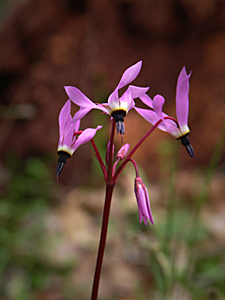 March 1: Skaggs Springs Rd near Annapolis Rd
March 1: Skaggs Springs Rd near Annapolis RdThis photo was sent in by Bob Keller of Mendocino. Henderson's shooting star, Dodecatheon hendersonii, can be found in dry meadows and open forest. Also called Broad-leaved shooting star, from the shape of its leaves.
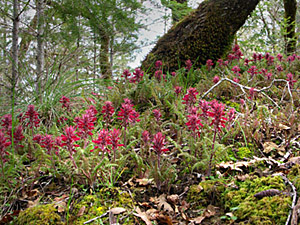 March 1: Skaggs Springs Rd near Annapolis Rd
March 1: Skaggs Springs Rd near Annapolis RdAnother from Bob Keller, a nice group of Indian warrior, Pedicularis densiflora. This common species is related to the paintbrushes.
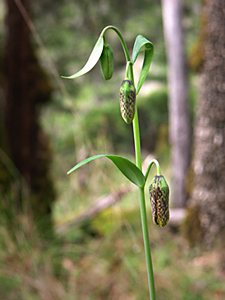 March 1: Skaggs Springs Rd near Annapolis Rd
March 1: Skaggs Springs Rd near Annapolis RdAlso from Bob Keller. Fritillary buds. Anyone have an idea of the species?
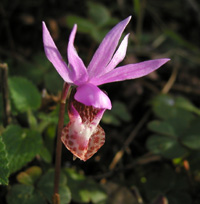 March: Gualala
March: GualalaWhen you chance upon the Fairyslipper or Calypso Orchid, Calypso bulbosa, get down on your knees for a whiff of its wonderfully sweet scent! While you're there, notice the intricate structure of the flower, with delicate hairs on the lower lip, and the single oval leaf on the ground at the base of the stem. The leaf is produced in the fall, and remains as the flower develops, until the next summer. Photo by Bob Rutemoeller, from 2004.
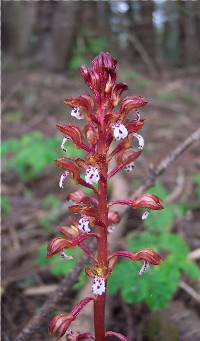 April: Grindle Park, Mendocino, CA
April: Grindle Park, Mendocino, CASpotted Coralroot, Corallorhiza maculata, a member of the Orchid family, is found in open shaded coniferous forest in decomposing leaf material. It and its close relative, western coralroot, Corallorhiza mertensiana, which lacks the reddish-purple spots on the lower lip, are widespread and common. Photo from 2004 contributed by Penny Lancaster.
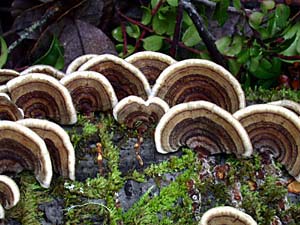 January, Soda Springs Reserve
January, Soda Springs ReserveIt's easy to see why this widespread fungus, Trametes versicolor, has the common name Turkey Tails! Photo taken by Norm Jensen.
